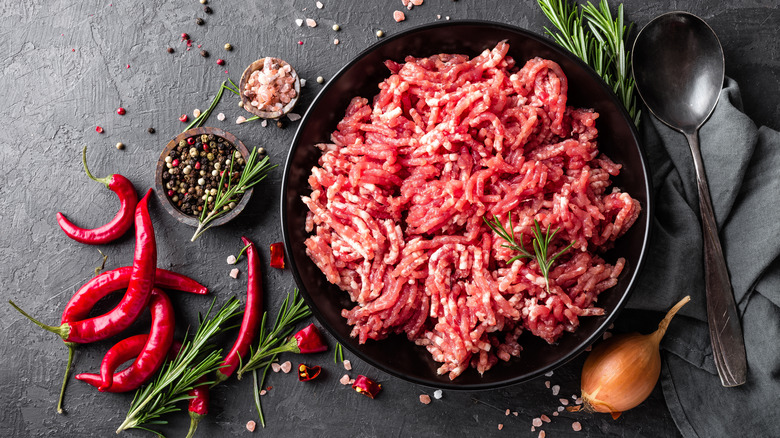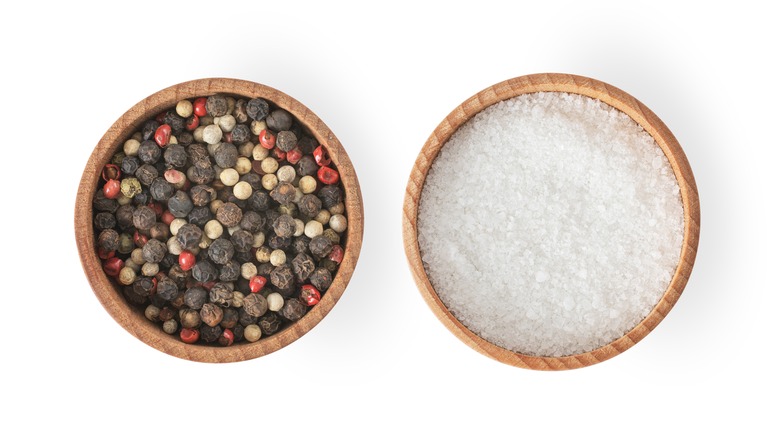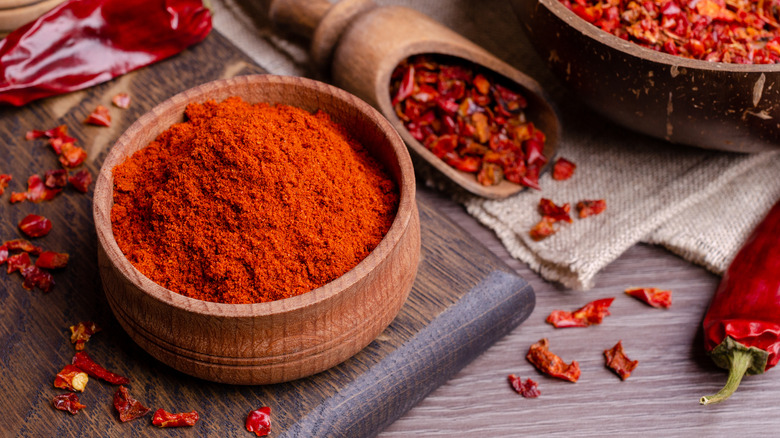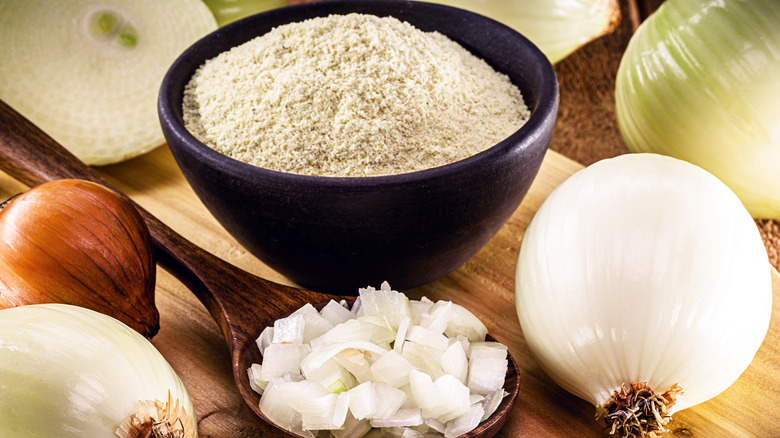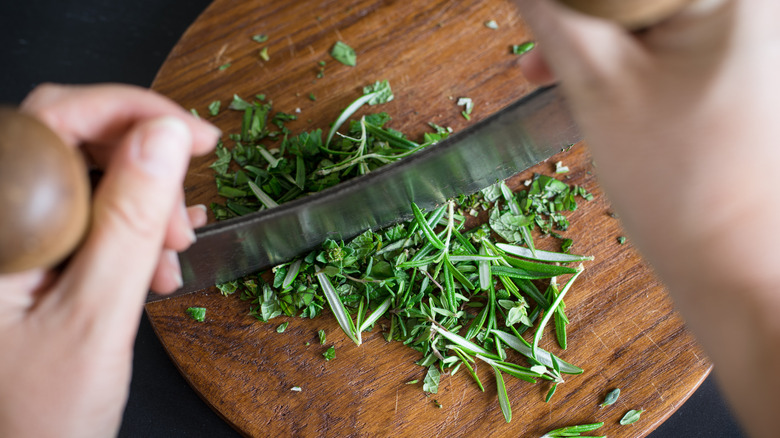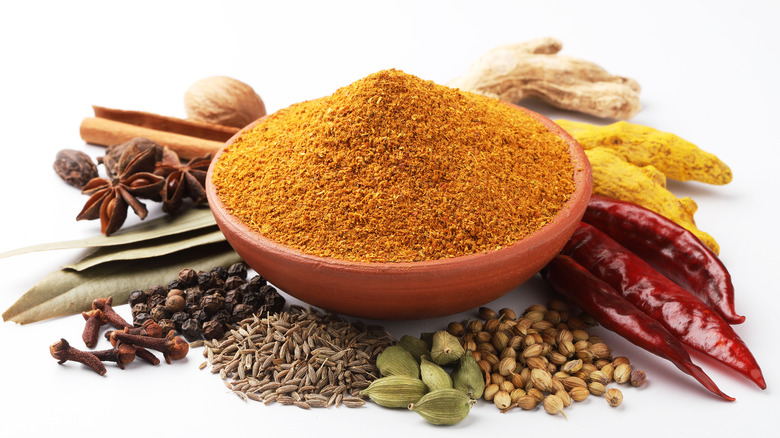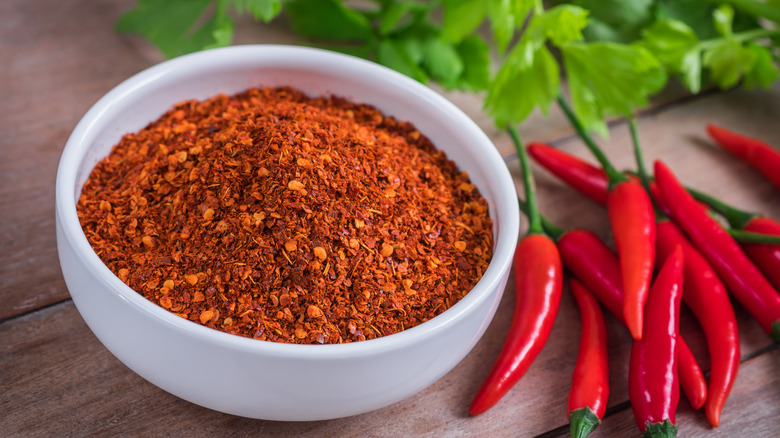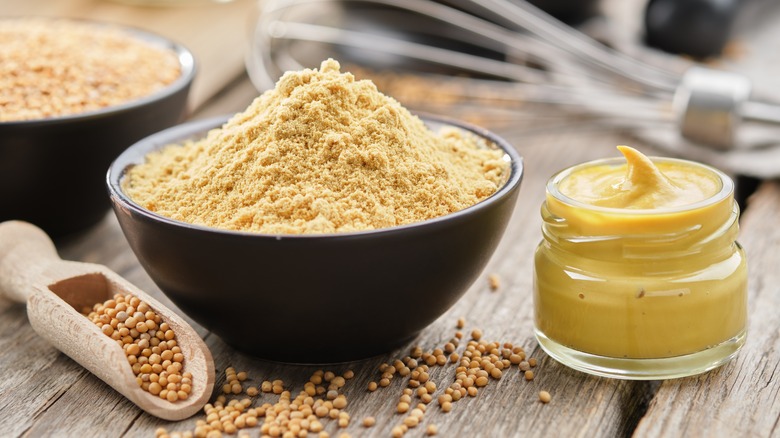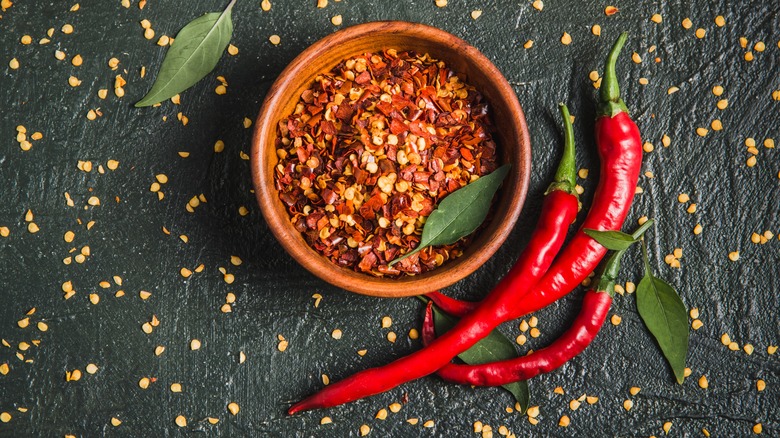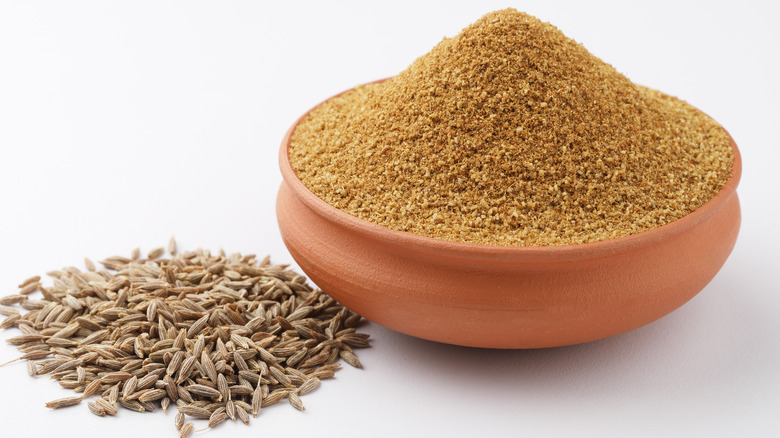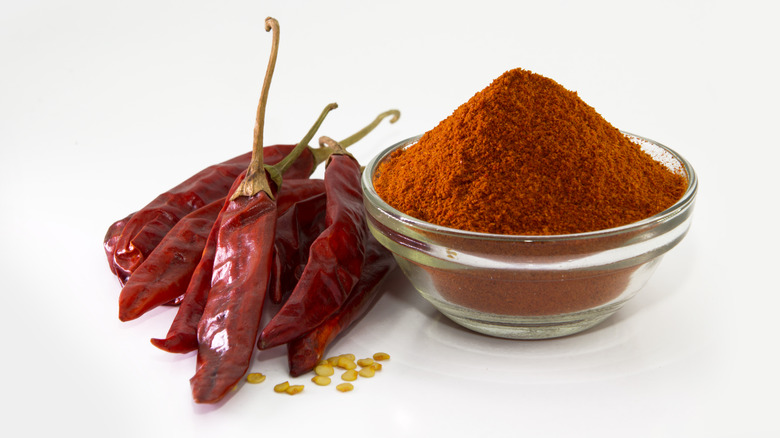11 Seasonings That Work Well With Ground Beef
We may receive a commission on purchases made from links.
Ground beef is a versatile protein that can be used in a wide variety of dishes. Whether you are a home cook or a professional chef, chances are you have experience cooking with it. It's a pretty popular option, and the average person consumes around 67 pounds of beef a year, as per the United States Department of Agriculture. As a widely devoured meat, it's worth knowing which spices and herbs can enhance it. By properly seasoning beef you'll highlight its natural flavors and make your meals more enjoyable, whether you're looking for a quick weeknight dinner or a hearty Sunday afternoon meal.
Ground beef plays a role in a variety of dishes from tacos to meatloaf. The ingredients you use to season the meat will change based on what you're making. From salt and pepper to more complex spice blends, there are numerous ways to amplify the taste. There's no doubt about it, ground beef can be transformed with all the right seasonings. Let's break down the top ingredients in our repertoire and examine how they elevate ground beef dishes, as well as tips to use them to their full potential.
1. Always include salt and pepper
It's no secret, ground beef can be seasoned in numerous ways. But let's begin with the basics: salt and pepper. When it comes to preparing beef, these two definitely top the list, and the pair is essential in any kitchen, with good reason. Salt enhances the natural flavors of food by bringing out sweetness and savoriness, while pepper adds subtle heat and pungency.
These two ingredients can really make a difference as to how much flavor a finished dish possesses, whether you are making burgers, meatballs, tacos, or any other ground beef recipe. The type of salt you use can also make a difference. Coarse sea salt or kosher salt are great choices as they tend to be less processed and have a more pronounced flavor than regular table salt. Meanwhile, grinding your own pepper is the freshest option to guarantee a stronger aroma.
Furthermore, timing the addition of the seasoning is the secret to a juicy bite. The specifics are a bit of a hot debate. Both can be included before cooking but will draw out moisture from the beef, ultimately causing it to release water and become tough to chew. It is generally recommended to sprinkle the classic duo on the browned meat when it's almost done cooking (via America's Test Kitchen). Adding the spices at the end allows the beef to cook in its own juices without losing moisture, resulting in a more tender final product.
2. Add a bit of smoked paprika
Few ingredients have an impact on a beef dish quite like smoked paprika, which is particularly common in Mediterranean, Central European, and Latin American cuisine. You may also see the spice referred to as smoked pimentón or Spanish paprika (via The Spice and Tea Shoppe). Regardless of its name, its distinct flavor and pigment don't go unnoticed. The vibrant red powder is a versatile spice that instantly adds warmth and a pop of color to meals.
Smoked paprika ranges in flavor from sweet and mild to spicy. The heat of the seasoning depends on the type of pepper used to make it. According to MasterClass, paprika is most commonly derived from various kinds of pepper ranging from mild-tasting sweet peppers to hot chili peppers. The peppers are dried over firewood in order to create a smoked taste.
The smoky flavor pairs well with many ground beef dishes like tacos and lettuce wraps. Depending on your heat tolerance, you may just want to add a dash. A little goes a long way and too much can overpower the other flavors in the dish. Start with about one teaspoon per pound of cooked beef. You can include the ingredient during the browning process to allow the flavors to meld together or sprinkle it on top for a brilliant finish.
3. Choose from different types of onion powder
Every home cook's pantry should contain at least one type of onion powder. It is a seasoning staple that adds flavor to a range of dishes without increasing moisture or changing the texture. The finely ground powder is a convenient way to get the taste of onions without having to chop and peel fresh ones.
Keep in mind that it is more concentrated than fresh onions, so you may need to use less in the recipe. The seasoning can go a long way in enhancing the taste of beef as it has a pungent flavor that is both savory and sweet. Onion powder can also help balance other ingredients in a recipe, especially if they are spicy.
Not all onion powders are the same though and each variety (white, red, and yellow) brings its own complexity and taste to ground beef. Of the three types, white onion powder is commonly used for its sharp aroma. It is still balanced with some sweetness, though the yellow kind is the sweetest. Red onion powder tends to be fairly mild though products from different brands may vary (via Miss Vickie). Consider the meal you're preparing and do a taste test to gauge the strength and flavor before adding onion powder to your dish.
4. Give it a noticeable garlic flavor
One of the most noticeable seasonings used on a regular basis may just be garlic. From hamburgers to sloppy joes, it is a flavorful and aromatic ingredient that is often found in ground beef recipes. The ways to use garlic are near endless, especially since the seasoning is offered in several forms. When cooking ground beef you can add any type you prefer, such as pre-minced garlic, garlic powder, garlic salt, or fresh garlic. Each variety will introduce a different level of sharpness to the dish you're cooking.
For a subtle taste, jarred or powdered styles may be the best option. Both have a milder flavor in comparison to other types. Fresh garlic is a little more customizable and fragrant, and cloves can be minced, chopped, or pressed for different levels of intensity. If you're having trouble, a simple garlic peeling hack consists of applying pressure to the cloves with the flat side of a knife.
If you're substituting fresh or powdered garlic in a recipe, keep in mind that one medium-sized clove is the equivalent of about ⅛ teaspoon of garlic powder seasoning (via All Plants). If you are cooking with fresh garlic, consider sautéing it before combining it with the meat to disperse the flavor. Sautéing garlic is a quick process and should only take a few minutes or you risk burning it. You can also add garlic to rubs or marinades and let it be absorbed by the meat.
5. Complete with Italian herbs
Herbs are an essential ingredient in many meals. Whether cooked separately or together, they add layers of flavors and a fresh aroma. Italian cuisine is known for its use of aromatic herbs, so by extension, Italian cooks have a knack for selecting the right combination of herbs to enhance the flavors of dishes including soup, pasta, and meat. Whether you're a professional chef at a fine restaurant or a home cook in your own kitchen, the key to tasty ground beef is adding Italian herbs.
Traditionally, this classic blend of seasonings typically includes a combination of basil, oregano, rosemary, thyme, parsley, marjoram, and sage. These ingredients are delightful when fresh but can be time-consuming to source and prepare every time you cook ground beef. Instead, opt for simplicity and supplement the fresh herbs with dried ones. You can purchase already ground, dehydrated versions of similar ingredients or make an Italian seasoning blend yourself. Some versions include garlic and onion powder too. This collection of herbs can easily transform ground beef by significantly increasing the flavor profile without having to purchase multiple herbs.
6. Consider a curry blend
Curry blends vary depending on the region, and the spice mix is commonly used in Indian, Thai, and South Asian cuisines. The seasoning may have ingredients such as cumin, coriander, turmeric, and chili peppers (via Raw Spice Bar). Given that the mixtures are regionally distinct, they can include ginger, mustard seeds, or coconut milk, for example.
When cooking with curry seasoning, the two most common types to use are ground powder and paste. The main difference between the powder and paste is that the latter is made from a combination of fresh and dry ingredients, giving it a more pronounced fragrance. There are three common types of curry paste — red, yellow, and green — each with its own unique taste and level of heat. Red is the spiciest, green is milder, and yellow is the subtlest.
To bring out the full flavor of curry paste no matter the color, it's important to cook it. Simply heat it in a saucepan on high with a little bit of oil until fragrant. High heat is necessary in order to release the aromatics of the paste, and the oil protects the spices from charring. This combination of spices can be store-bought for convenience but making your own mixture allows you to control the level of heat.
7. Spice it up with cayenne pepper
Whether you're a spice lover or just looking to turn up the heat, try adding cayenne pepper to your next ground beef recipe. It's a popular spice in many cuisines such as Mexican, Cajun, and Indian (via Spice and Life). However, you may best recognize the intense flavor from your favorite hot sauce, dips, or spreads.
Cayenne pepper is the spice equivalent of a wild card — a little goes a long way and it packs a big punch. It is a part of the nightshade family and is typically long, thin, red, and hot (via Chili Pepper Madness). This fiery red pepper is well known for its bright color and ability to add a super spicy kick to most dishes. The level of heat varies depending on the source and preparation, but it is generally considered to be one of the hotter peppers with a rating of 30,000 to 50,000 on the Scoville scale.
Measure out about ¼ teaspoon of cayenne pepper to start and adjust based on your heat tolerance. This ingredient can be added at different stages of the cooking process, either at the beginning, while browning the beef, or at the end to add a burst of heat. Be mindful of any other spicy seasonings you are using and modify accordingly.
8. Mustard powder adds a unique tang
While you may be used to using mustard as a condiment, it is also a seasoning. Mustard is more complementary to beef than you may think — not the sauce in a bottle, but rather the powder form. Ground mustard, otherwise known as English mustard, is an underrated element to use when cooking with ground beef. Similar to regular mustard in taste, the yellow-brown spice introduces a lower acid yet still vinegary flavor to the meat.
Mustard powder is typically made from ground yellow seeds, which have a milder flavor. There are three varieties to choose from according to Mustard Maker: black, brown, and white. Each one provides a unique flavor profile to the protein.
When cooking with dry mustard itself, you may not notice a distinct taste at first. Simply adding it as is won't do much to flavor the ground beef. Before using it to season the protein, the ground mustard must be combined with water, vinegar, or oil to form a paste. This process helps release oils in the powder to give it an extra bit of zing. You can use the blend as a marinade, spread, or additive in sauces. This unassuming seasoning also tenderizes meat and can be used as a bonding agent for liquid components like eggs and oil.
9. Keep the heat with red pepper flakes
It's likely you'll find red pepper flakes in most pizzerias across the country. The popular garnish is also a go-to seasoning to reach for when making ground beef. Commonly referred to as crushed red pepper, these small dried pieces of chili pepper are made from a mix of peppers including jalapeño, bell, and cayenne varieties. This seasoning is perfect to add to a dish when you don't want every bite to be popping with heat. However, red pepper flakes can still be quite hot depending on the type of chili pepper used. The heat level can also be affected by how much of the seeds and veins are included in the flakes, which is what gives the pepper its spicy kick.
The spiciness of the pepper adds a nice level of heat whether you are making burgers, burritos, or stuffed peppers. Red pepper flakes are easy to find and straightforward to cook with, and you can add them to the protein at different points in the process for varying levels of depth. Try sprinkling flakes on a final dish or combining them with other ingredients for a flavorful meal. Whatever ground beef recipe you're making, a dash of red pepper flakes is sure to take it up a notch.
10. Sprinkle in some cumin
Dried herbs and spices are essential for flavor, but few have reigned supreme since the dawn of time. Cumin goes pretty far back and has been used for thousands of years, originally by the ancient Greeks and Romans (via Pacific Spice). Still trending today, cumin is a great ingredient to use to add layers of flavor and complexity to your meals, particularly those made with ground beef. It's a pivotal spice in a variety of cuisines like Middle Eastern and Indian and continues to be a staple in many others.
Cumin is made from dried seeds of the cumin plant, which is actually considered to be a part of the parsley family, according to the McCormick Science Institute. The small, oblong seeds are ground into a powder to use as an ingredient for cooking and you can find it as a powder or as a whole seed at most major supermarkets. The old spice produces a warm, earthy, and nutty flavor profile. It pairs well with many other ingredients, making it an ideal additive for most beef recipes like meatloaf and meatballs.
11. Turn up the spice with chili powder
A dash of chili powder is all it takes to add a hint of heat and vibrancy to your beef dishes. Keep an eye out when choosing the product, as it is not to be confused with chile powder, an entirely different seasoning. Ground hot peppers make ground chile powder, whereas chili powder typically has a few added ingredients besides the pepper (via Southern Living). This seasoning often includes a blend of cumin, ginger, oregano, paprika, and assorted spices, which will give your ground beef a bold, spicy flavor. It's a common ingredient to use in chili, hamburgers, and burritos.
When seasoning meat with this spice blend, timing is everything. Try adding it during the browning process for the best results. This method allows the seasoning to cook with the beef, infusing it with flavor. It also helps to release the oils in the chili powder which can help enhance the aromas. Be cautious not to add too much, as the heat level can range from mild to extremely hot. Begin with about one teaspoon and gradually increase the seasoning as your tastebuds desire. This will help you find the perfect balance of heat and flavor.
